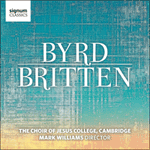The melody is not of English origin. It was already popular internationally in the 1560s; a version was published in Erfurt in 1572 with the title
Von Gott will ich nicht lassen (and a later version of this chorale occurs in several of Bach’s vocal and organ works: see BWV417-419, 658). Since Byrd’s arrangement of the Dorian G minor tune and his two lively variations on it probably date from the 1580s or 1590s, the dedicatee would appear to be Queen Elizabeth. The structure of the melody is of two unequal phrases, the first of four bars, the second twice as long, and each carries its own varied repeat. This whole structure is then repeated twice by Byrd. As is usual in such variations, a descant is placed over the original melody in the last section, and in this case it is particularly fine, soaring in vocal style to the highest note of the instrument. This work illustrates how misleading the titles of Byrd’s works can sometimes be.
The Queenes Alman is in many ways similar to
Rowland, where Byrd adds two variations onto a comparable pre-existent tune in G minor. To consider them as different just because one is a ‘dance’ and the other a set of ‘song variations’ would be an artifical and arbitary distinction which pays more attention to what Byrd started with than what he did with his material.
from notes by Davitt Moroney © 1999
La mélodie n’est pas d’origine anglaise. Elle avait déjà une popularité internationale dans les années 1560 ; une version a été publiée à Erfurt en 1572, intitulée
Von Gott will ich nicht lassen (et une version plus tardive de ce choral figure dans plusieurs œuvres de Bach ; voir les BWV 417-19, 658). L’arrangement fait par Byrd de cette mélodie en sol mineur (mode dorien, transposé) avec deux variations vigoureuses, semble dater des années 1580 ou 1590 ; la dédicataire serait ainsi la reine Élisabeth et non pas la reine Anne (femme de Jacques Ier). La mélodie comporte deux phrase inégales. La première est de quatre mesures, la seconde de huit (chacune avec une reprise variée). Toute cette structure est reprise deux fois par Byrd. Comme d’habitude à la fin de telles variations, un déchant est placé au-dessus de la mélodie originale. Ici il est particulièrement réussi, planant de façon vocale vers la note la plus aiguë du clavier. Cette œuvre illustre à quel point les titres peuvent parfois nous induire en erreur.
The Queenes Alman est en tous points similaire à
Rowland, où Byrd ajoute deux variations de sa propre composition à une chanson en sol mineur. Les considérer comme deux différentes sortes de compositions, l’une “danse” et l’autre “variations”, est artificiel et arbitraire. Dans les deux cas, Byrd agit exactement de la même façon pour construire son œuvre.
extrait des notes rédigées par Davitt Moroney © 1999


 Byrd & Britten: Choral works
Byrd & Britten: Choral works
